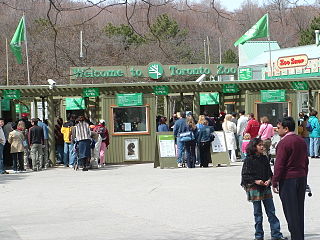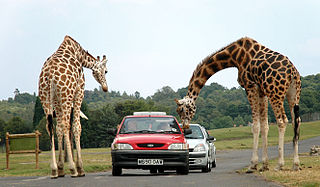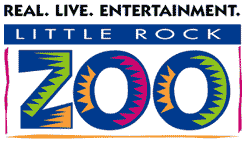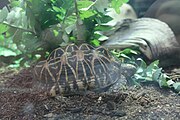
The Cincinnati Zoo & Botanical Garden is the sixth oldest zoo in the United States, founded in 1873 and officially opening in 1875. It is located in the Avondale neighborhood of Cincinnati, Ohio. It originally began with 64.5 acres (26.1 ha) in the middle of the city, but has spread into the neighboring blocks and several reserves in Cincinnati's outer suburbs. It was appointed as a National Historic Landmark in 1987.
The Saint Louis Zoo, officially known as the Saint Louis Zoological Park, is a zoo in Forest Park, St. Louis, Missouri. It is recognized as a leading zoo in animal management, research, conservation, and education. The zoo is accredited by the Association of Zoos and Aquariums (AZA). Admission is free based on a public subsidy from a cultural tax district, the Metropolitan Zoological Park and Museum District (ZMD); fees are charged for some special attractions. A special feature is the 2 ft narrow-gauge Emerson Zooline Railroad with passenger trains pulled by Chance Rides C.P. Huntington locomotives that encircle the zoo, stopping at the more popular attractions.

The National Zoological Park, commonly known as the National Zoo, is one of the oldest zoos in the United States. The zoo is part of the Smithsonian Institution and does not charge admission. Founded in 1889, its mission is to "provide engaging experiences with animals and create and share knowledge to save wildlife and habitats".

The San Diego Zoo is a zoo in Balboa Park, San Diego, California, housing 4,000 animals of more than 650 species and subspecies on 100 acres (40 ha) of Balboa Park leased from the City of San Diego. Its parent organization, San Diego Zoo Wildlife Alliance, is a private nonprofit conservation organization, and has one of the largest zoological membership associations in the world, with more than 250,000 member households and 130,000 child memberships, representing more than a half million people.

Schönbrunn Zoo is a 17-hectare (42-acre) zoo in the city of Vienna, Austria. Established in 1752, it is the world's oldest zoo still in operation. It is also a UNESCO World Heritage Site, being a part of the Schönbrunn Palace gardens. It generally receives more than 2 million visitors every year.

Whipsnade Zoo, formerly known as ZSL Whipsnade Zoo and Whipsnade Wild Animal Park, is a zoo and safari park located at Whipsnade, near Dunstable in Bedfordshire, England. It is one of two zoos that are owned by the Zoological Society of London (ZSL), a charity devoted to the worldwide conservation of animals and their habitats.

The Toronto Zoo is a zoo located in Toronto, Ontario, Canada. Encompassing 287 hectares, the Toronto Zoo is the largest zoo in Canada. It is divided into seven zoogeographic regions: Indo-Malaya, Africa, Americas, Tundra Trek, Australasia, Eurasia, and the Canadian Domain. Some animals are displayed indoors in pavilions and outdoors in what would be their naturalistic environments, with viewing at many levels. It also has areas such as the Kids Zoo, Waterside Theatre, and Splash Island. It has one of the most taxonomically diverse collection of animals on display of any zoo worldwide; it is currently home to over 5,000 animals representing over 500 species. The zoo is open to the public every day of the year except December 25.

West Midlands Safari Park is a safari park located in Bewdley in Worcestershire, England. It was opened under the name of West Midland Safari Park in Spring 1973.

Dublin Zoo, in Phoenix Park, is a zoo in Dublin, Ireland, and one of Dublin's most popular attractions. Established and designed in 1830 by Decimus Burton, it opened the following year. Today it focuses on conservation projects, breeding programmes, and growing awareness for animals. Its stated mission is to "work in partnership with zoos worldwide to make a significant contribution to the conservation of the endangered species on Earth".

The Mesker Park Zoo and Botanic Garden is a zoo that opened in 1928 in Evansville, Indiana, United States. It is located in Mesker Park on Evansville's northwest side and is run by the City of Evansville.

The Wilder Institute/Calgary Zoo is located in Bridgeland, Calgary, Alberta, Canada, just east of the city's downtown and adjacent to the Inglewood and East Village neighborhoods. It is accessible via Calgary's C-Train light rail system, by car via Memorial Drive, and by bicycle and footpath via the Bow River pathway. A large portion of the zoo is located on St. George's Island in the Bow River.

Blackpool Zoo is a 32-acre (13 ha) zoo, owned by Parques Reunidos and located in the sea-side resort of Blackpool, Lancashire, England. It provides a home to over 1,350 animals from all over the world.

The Little Rock Zoo was founded in 1926 and is located in Little Rock, Arkansas, United States. It is home to more than 725 animals representing over 200 species, and covers an area of 33 acres (13 ha). The Arkansas Zoological Foundation is a private 501 c (3) organization that raises funds for zoo development. The Little Rock Zoo is a department of the city of Little Rock. It is the largest zoo in Arkansas, and the only Arkansas zoo accredited by the Association of Zoos and Aquariums (AZA).

Colchester Zoo is a zoological garden situated near Colchester, England. The zoo opened in 1963 and celebrated its 60th anniversary on 2 June 2023. It is home to many rare and endangered species, including big cats, primates and birds as well as many invertebrates and fish species.
The Roger Williams Park Zoo of Providence, Rhode Island, contains more than 800 animals in natural settings from a total of 160 species from around the world. In 1986, the zoo became the first zoo in New England to earn accreditation from the Association of Zoos and Aquariums. Founded in 1872, the zoo is the third oldest zoo in the nation. The zoo and the nearby Carousel Village are some of the main attractions of Roger Williams Park.

Woburn Safari Park is a safari park located in Woburn, Bedfordshire, England. Visitors to the park can drive through exhibits, which contain species such as southern white rhino, elephants, tigers and black bears. It is part of the estates of the Duke of Bedford that also includes Woburn Abbey and its 3,000-acre (1,200 ha) deer park. The Safari Park itself covers 360 acres (150 ha).

The Kansas City Zoo & Aquarium is a 202-acre (82 ha) zoo founded in 1909 and is located in Swope Park at 6800 Zoo Drive, Kansas City, Missouri, in the United States. The zoo has a Friends of the Zoo program to help promote the work of the zoo which sees over one million visitors a year. The zoo is home to nearly 1,700 animals and the aquarium has around 8,000 animals. The zoo is an accredited member of the Association of Zoos and Aquariums (AZA).

Shanghai Zoological Park, or commonly Shanghai Zoo in short, is the main zoological garden in Shanghai. It is located near the township of Hongqiao and is administratively in Changning District. Shanghai Zoo was formerly known as " Xijiao Park", which is still a common name used locally for the zoo.
The Greater Vancouver Zoo is a 49-hectare (120-acre) privately-run zoo located in Aldergrove, British Columbia, Canada. The zoo was established in 1970 as the Vancouver Game Farm. Since then it has undergone two name changes, being briefly renamed as the Greater Vancouver Zoological Centre in 1995, before it adopted its present name in 1999. As of 2023, the zoo is home to 180 animals, representing over 100 different species, including several orphaned, rescued and otherwise non-releasable individuals. The zoo's mission statement is "to inspire appreciation of our ecosystems and support conservation efforts by engaging the community."

Metro Richmond Zoo is a privately owned, for-profit zoo in Chesterfield County, Virginia. It is located in the central Virginia area, off of U.S. Route 360, about 20 miles southwest of Richmond. Metro Richmond Zoo encompasses about 70 acres (28 ha) and houses around 2,000 animals representing over 190 species, including reticulated giraffe, white rhinoceros, snow leopard, cheetah and Grant's zebra.































